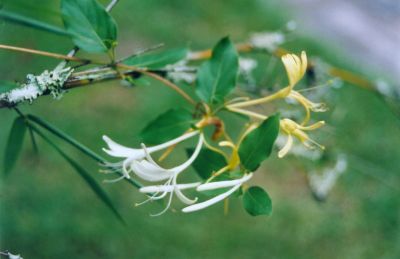- Japanese Honeysuckle
Taxobox
name = Japanese Honeysuckle

image_width = 240px
regnum =Plant ae
divisio = Magnoliophyta
classis = Magnoliopsida
ordo =Dipsacales
familia =Caprifoliaceae
genus = "Lonicera "
species = "L. japonica"
binomial = "Lonicera japonica"
binomial_authority = Thunb.The Japanese Honeysuckle ("Lonicera japonica"; Suikazura or スイカズラ in Japanese) is a species of
honeysuckle native to easternAsia includingJapan ,Korea , northern and easternChina , andTaiwan , which is a majorinvasive species inNorth America . It is a twiningvine able to climb up to 10 m high or more intree s, with opposite, simple oval leaves 3–8 cm long and 2–3 cm broad. Theflower s are double-tongued, opening white and fading to yellow, and sweetly scented. Thefruit is a globose dark blueberry 5–8 mm diameter containing numerousseed s.Cultivation and uses
This species is sold by American nurseries, often as the
cultivar 'Hall's Prolific' ("Lonicera Japonica var. Halliana"). It is an effective groundcover, and has pleasant, strong-smellingflower s. It can be cultivated byseed , cuttings, orlayering . In addition, it will spread itself viashoot s if given enough space to grow.Japanese Honeysuckle has become naturalized in
Argentina ,Brazil ,Mexico ,New Zealand and much of theUnited States , includingHawaii , as well as a number of Pacific and Caribbean islands.Japanese Honeysuckle is classified as a noxious weed in
Illinois andVirginia . It can be controlled by cutting or burning the plant to root level and repeating at two-week intervals until nutrient reserves in the roots are depleted. It can also be controlled through annual applications ofglyphosate , or through grubbing if high labor and soil destruction are not of concern. Cutting the Honeysuckle to within 5–10 cm of the ground and then applying glyphosate has proved to be doubly effective, provided that the mixture is rather concentrated (20–25%) and is applied immediately after making the cut.Chinese Medicine
The Japanese Honeysuckle flower is of high medicinal value in
traditional Chinese medicine , where it is called rěn dōng téng (忍冬藤; literally "winter enduring vine") or jīn yín huā (; literally "gold silver flower"). Alternate Chinese names include Er Hua and Shuang Hua.ref|Chen1 It has antibacterial and anti-inflammatory properties, and is used (often in combination with "Forsythia suspensa") to dispel heat and remove toxins, including carbuncles, fevers,influenza andulcer s. In Korean, it is called "geumeunhwa". The dried leaves are also used in traditional Chinese medicine.Jin Yin Hua (Japanese Honeysuckle, Flos Lonicerae Japonicae) is notable for its inclusion in the traditional Chinese medicine herbal formula Honeysuckle and Forsythia Powder. In pinyin, this formula is called Yin Qiao San. Traditional indications for use of this formula include fever, headache, cough, thirst, and sore throat.ref|Bensky1 For indications such as this, it is common to find Japanese Honeysuckle paired in Chinese medicine herbal formulations with Forsythia (Lian Qiao, Fructus Forsythiae Suspensae). According to Chinese medicine, these herbs, when combined, have a synergistic medicinal effect to address indications such as fever with headache and sore throat. This is why these two herbs are considered "paired herbs."
In Chinese medicine, Jin Yin Hua is classfied with a temperature property of cold. The cold designation specifically refers to, in this case, to Jin Yin Hua's anti-toxin, anti-bacterial, anti-pyretic, and anti-inflammatory properties.ref|Yeung Also, according to traditional Chinese medicine, Jin Yin Hua is contraindicated for patients with medical conditions that are diagnosed as deficient and cold in nature unless combined with other herbs to balance the temperature nature of Jin Yin Hua. In layperson terms, Jin Yin Hua is used in Chinese medicine to address what are called excess heat conditions such as fevers, skin rashes, and sore throat. Excess heat conditions are essentially inflammatory processes involving heat, redness, pain, and swelling often due to external pathogenic factors such as bacteria and viruses. The cold nature of Jin Yin Hua is considered to cool the heat nature of the heat related conditions. For example, Jin Yin Hua's antibacterial properties can help to cool a fever. In this case, the cold herb treats the heat condition. However, should a patient present with what is termed as a cold condition such as aversion to cold with cold limbs, cold and pain in the abdomen, and abdominal pain relieved by warmth,ref|Feit then Jin Yin Hua's cold nature is said to be contraindicated for treating the pre-existing cold condition. Should an herbalist choose to use Jin Yin Hua in an herbal formula for a patient with a cold condition, he/she would then choose to balance the temperature of Jin Yin Hua with another herb that is warming in nature.
External links
* [http://tai2.ntu.edu.tw/udth/bin/fot1.exe/browse?BID=4&page=744 Flora of Taiwan: "Lonicera japonica"]
* [http://www.pfaf.org/database/plants.php?Lonicera+japonica Plants For A Future: Lonicera japonica]Notes
# Chinese Medical Herbology and Pharmacology, John and Tina Chen, Art of Medicine Press, 1st ed. 2001, p. 171
# Chinese Herbal Medicine Formulas & Strategies, Dan Bensky and Randall Barolet, Eastland Press, 2nd edition 1991, p.44
# Handbook of Chinese Herbs and Formulas, Vol.1, Him-che Yeung, Institute of Chinese Medicine, 1985, p.317
# Acumoxa Therapy Reference and Study Guide, Vol. 1, Richard Feit and Paul Zmiewski, Paradigm Publications, 1989, p.68-69.
Wikimedia Foundation. 2010.
